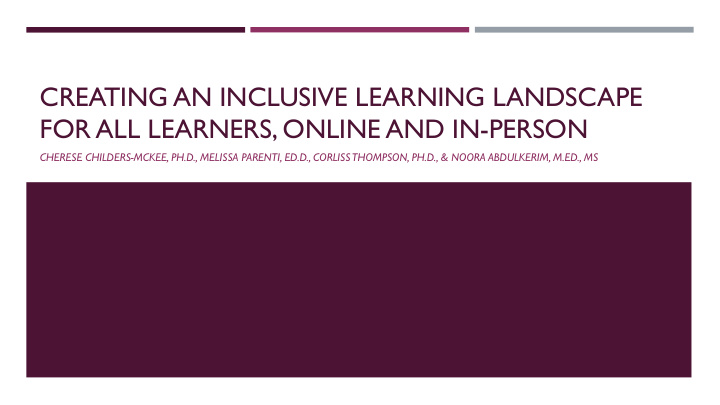



CREATING AN INCLUSIVE LEARNING LANDSCAPE FOR ALL LEARNERS, ONLINE AND IN-PERSON CHERESE CHILDERS-MCKEE, PH.D., MELISSA PARENTI, ED.D., CORLISS THOMPSON, PH.D., & NOORA ABDULKERIM, M.ED., MS
TELL US ABOUT YOU!
DIALOGUES ACROSS DIFFERENCE: INITIATING, CREATING, AND SUSTAINING CHANGE IN A DIVERSE COLLEGE COMMUNITY (1.)To build the college community’s awareness and skills related to diversity and inclusion (2.) To identify key challenges of the community related to diversity and inclusion (3.) To create a way to build community across differences of identity and location (4.) To use the lessons-learned from the conversation series to create a more equitable and just college climate.
BEFORE … A - I'm going to go ahead and get started I'm not sure why that's not working. B - We can hear you now. A - Can you hear me now? B -Yeah, I can hear you. A - Yeah, you’re breaking up. B – I’m breaking up. Sorry let me try something else. Okay what about now? A - Okay, That’s better. All right let me pick up again.
“TAKE TWO …”
SENSOY, O., & DIANGELO, R. (2017). IS EVERYONE REALLY EQUAL?: AN INTRODUCTION TO KEY CONCEPTS IN SOCIAL JUSTICE EDUCATION . TEACHERS COLLEGE PRESS. GUIDELINE 3: LET GO OF ANICDOTAL EVIDENCE AND INSTEAD EXAMINE PATTERNS
AFTER … A - Any folks from online want to share? A - Thank you for everyone that has joined me online. I’d love to hear any comments that you might have about the first question.
AND THEN … I felt like the online participants actually had an easier time jumping in. It was a little hard for those of us in the room because online questions were often taken first.
METHODOLOGY 20 item survey was designed and tested for face validity (Creswell, 2009) Administered electronically at the close of each of the six sessions. 7 point likert scale and open-ended response items. Open-ended responses were coded and themes identified Two researchers individually reviewed open-ended responses and independently created a set of initial descriptive codes Discussion between the two researchers occurred to develop a final set of invivo codes and operational definitions prior to the second coding pass Data analysis concluded with the discussion between researchers re. themes that emerged
THEME PARTICIPANT RESPONSE “Tend to be isolated” “As an online student, we tend to be isolated from the rest of the community” “Makes some of this difficult” “Being in an online environment makes some of this difficult so ways to allow more inclusivity in this environment is challenging” “One big challenge is establishing an inclusive culture in an online class, due to the lack of synchronous conversations and face-to- face contact.” “Audio was weak” “Presenter audio was weak at times.” “Audio interference; call quality” “I was online and the sound was very poor. What I gained most was connecting to others (widening my community) who work on/care about these issues” “Format is tricky” “The mixed format is tricky ” “The format and time allotted just didn't leave room for much depth - engagement/dialogue.”
THEME PARTICIPANT RESPONSE “Creating Communities” “I think online programs need to work on creating communities . creating a scaffold for connections and community to develop” “Fostering ‘virtual’ communities” “More interaction”, “More dialogue” “ More interaction ” “Less power point, more dialogue .” “More structure” “ More structure , ability to raise hands” “More structured questions/breakout rooms” “Online facilitation" “The moderator for online was fantastic, without her it would not have been a very good online experience.” “I appreciated the online facilitation . Perhaps more people in the room can connect online so that they can share their ideas as well.”
1. GARRISON, D. R. (2007). ONLINE COMMUNITY OF INQUIRY REVIEW: SOCIAL, COGNITIVE, AND TEACHING PRESENCE ISSUES. JOURNAL OF ASYNCHRONOUS LEARNING NETWORKS , 11 (1), 61-72 2. KOEHLER, M., & MISHRA, P. (2009). WHAT IS TECHNOLOGICAL PEDAGOGICAL CONTENT KNOWLEDGE (TPACK)?. CONTEMPORARY ISSUES IN TECHNOLOGY AND TEACHER EDUCATION , 9 (1), 60-70. SOCIAL TECHNOLOGY PRESENCE COGNITIVE TEACHING PEDAGOGY CONTENT PRESENCE PRESENCE
COGNITIVE PRESENCE CONTENT SOCIAL PRESENCE PEDAGOGY TEAHCING PRESENCE TECHNOLOGY “Creating Communities” “More interaction”, “More dialogue” “More structure” “Online facilitation"
DESIGN YOUR OWN SCENARIO 1 2 3 4 INTERNATIONAL ADMINISTRATION ASSIGNMENT DISABILITY LOCAL COMMUNITY CONFERENCE PREP GENDER FACULTY CURRICULUM MENTAL HEALTH STUDENTS POLICY RACE
GUIDELINE 3: LET GO OF ANICDOTAL EVIDENCE AND INSTEAD EXAMINE PATTERNS SENSOY, O., & DIANGELO, R. (2017). IS EVERYONE REALLY EQUAL?: AN INTRODUCTION TO KEY CONCEPTS IN SOCIAL JUSTICE EDUCATION . TEACHERS COLLEGE PRESS. WHAT PATTERNS DO WE HEAR IN OUR PROBLEM SOLVING? WHAT ARE ”PATTERNS TO PRACTICE SEEING”?
THANK YOU FOR SHARING ALL OF YOUR IDEAS & TIME TODAY! CHERESE CHILDERS-MCKEE, PH.D. – C.CHILDERS-MCKEE@NORTHEASTERN.EDU MELISSA PARENTI, ED.D. – M.PARENTI@NORTHEASTERN.EDU CORLISS THOMPSON, PH.D. – CO.BROWN@NORTHEASTERN.EDU NOORA ABDULKERIM, M.ED., MS. – ABDULKERIM.N@HUSKY.NEU.EDU
Recommend
More recommend